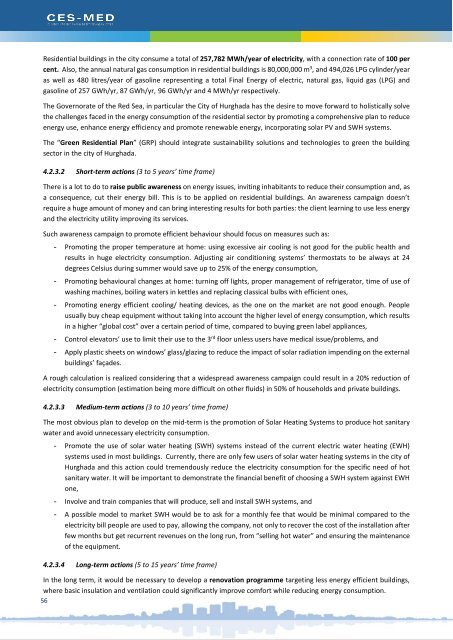020318_Hurghada SECAP_FINAL
You also want an ePaper? Increase the reach of your titles
YUMPU automatically turns print PDFs into web optimized ePapers that Google loves.
Residential buildings in the city consume a total of 257,782 MWh/year of electricity, with a connection rate of 100 per<br />
cent. Also, the annual natural gas consumption in residential buildings is 80,000,000 m 3 , and 494,026 LPG cylinder/year<br />
as well as 480 litres/year of gasoline representing a total Final Energy of electric, natural gas, liquid gas (LPG) and<br />
gasoline of 257 GWh/yr, 87 GWh/yr, 96 GWh/yr and 4 MWh/yr respectively.<br />
The Governorate of the Red Sea, in particular the City of <strong>Hurghada</strong> has the desire to move forward to holistically solve<br />
the challenges faced in the energy consumption of the residential sector by promoting a comprehensive plan to reduce<br />
energy use, enhance energy efficiency and promote renewable energy, incorporating solar PV and SWH systems.<br />
The “Green Residential Plan” (GRP) should integrate sustainability solutions and technologies to green the building<br />
sector in the city of <strong>Hurghada</strong>.<br />
4.2.3.2 Short-term actions (3 to 5 years’ time frame)<br />
There is a lot to do to raise public awareness on energy issues, inviting inhabitants to reduce their consumption and, as<br />
a consequence, cut their energy bill. This is to be applied on residential buildings. An awareness campaign doesn’t<br />
require a huge amount of money and can bring interesting results for both parties: the client learning to use less energy<br />
and the electricity utility improving its services.<br />
Such awareness campaign to promote efficient behaviour should focus on measures such as:<br />
- Promoting the proper temperature at home: using excessive air cooling is not good for the public health and<br />
results in huge electricity consumption. Adjusting air conditioning systems’ thermostats to be always at 24<br />
degrees Celsius during summer would save up to 25% of the energy consumption,<br />
- Promoting behavioural changes at home: turning off lights, proper management of refrigerator, time of use of<br />
washing machines, boiling waters in kettles and replacing classical bulbs with efficient ones,<br />
- Promoting energy efficient cooling/ heating devices, as the one on the market are not good enough. People<br />
usually buy cheap equipment without taking into account the higher level of energy consumption, which results<br />
in a higher “global cost” over a certain period of time, compared to buying green label appliances,<br />
- Control elevators’ use to limit their use to the 3 rd floor unless users have medical issue/problems, and<br />
- Apply plastic sheets on windows’ glass/glazing to reduce the impact of solar radiation impending on the external<br />
buildings’ façades.<br />
A rough calculation is realized considering that a widespread awareness campaign could result in a 20% reduction of<br />
electricity consumption (estimation being more difficult on other fluids) in 50% of households and private buildings.<br />
4.2.3.3 Medium-term actions (3 to 10 years’ time frame)<br />
The most obvious plan to develop on the mid-term is the promotion of Solar Heating Systems to produce hot sanitary<br />
water and avoid unnecessary electricity consumption.<br />
- Promote the use of solar water heating (SWH) systems instead of the current electric water heating (EWH)<br />
systems used in most buildings. Currently, there are only few users of solar water heating systems in the city of<br />
<strong>Hurghada</strong> and this action could tremendously reduce the electricity consumption for the specific need of hot<br />
sanitary water. It will be important to demonstrate the financial benefit of choosing a SWH system against EWH<br />
one,<br />
- Involve and train companies that will produce, sell and install SWH systems, and<br />
- A possible model to market SWH would be to ask for a monthly fee that would be minimal compared to the<br />
electricity bill people are used to pay, allowing the company, not only to recover the cost of the installation after<br />
few months but get recurrent revenues on the long run, from “selling hot water” and ensuring the maintenance<br />
of the equipment.<br />
4.2.3.4 Long-term actions (5 to 15 years’ time frame)<br />
In the long term, it would be necessary to develop a renovation programme targeting less energy efficient buildings,<br />
where basic insulation and ventilation could significantly improve comfort while reducing energy consumption.<br />
56

















